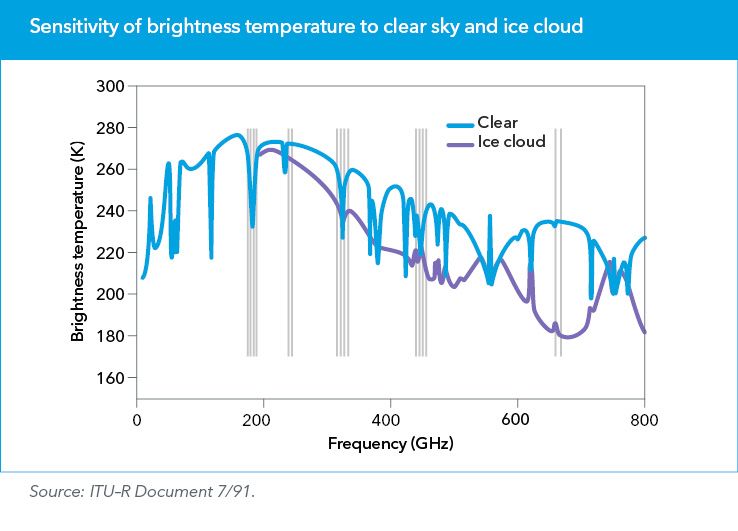
Passive microwave sensing of ice clouds: Key for nowcasting and climate modelling


Markus Dreis, Chairman, ITU–R Working Party 7C (Remote sensing systems), and Frequency Manager, European Organisation for the Exploitation of Meteorological Satellites (EUMETSAT)
Ice clouds cover more than one third of the Earth’s surface. They affect precipitation, atmospheric structure and cloud processes, with a great impact on the planet’s climate and hydrological cycles.
Global measurements of their properties — including ice-water path and ice-particle size distribution — are critical to understand the global effects of ice clouds.
To obtain ice-cloud measurements, passive microwave remote-sensing instruments observe the atmosphere at microwave frequencies that are carefully selected to retrieve atmospheric components. Those measurements can best be observed in specific “channels” at frequencies around 183 gigahertz (GHz), 243 GHz, 325 GHz, 448 GHz, and 664 GHz (see figure).

The figure compares brightness temperatures relative to a clear sky and an ice cloud. The bars indicate the ice-cloud channel positions.
These channels must be observed as a set, because observations from multiple microwave frequencies are needed to retrieve specific physical parameters. The resulting data is fed into regional and global weather and climate models to properly represent the radiative and thermodynamic effects of ice clouds.
New sensors optimized for ice clouds
Today’s operational passive microwave sensors typically observe the atmosphere at frequencies below 200 GHz or use limb sounding to measure chemical processes and atmospheric composition. Unfortunately, these methods are inadequate for optimal ice-cloud observation.
Passive microwave sensors, specifically optimized to measure ice clouds, are now under development, set to become operational by 2026. A prime example is the Ice Cloud Imager (ICI) on the Polar System-Second Generation (EPS-SG) satellites operated by EUMETSAT — the European Organisation for the Operation of Meteorological Satellites.
Those newly designed sensors will perform observations at the set of microwave frequencies outlined in the figure, using 11 channels ranging from 183 GHz up to 664 GHz. A conical scanning mechanism will provide good cloud-penetration capability at different cloud heights, and sensitivity to ice particles at a large range of sizes.
The new ICI instruments will furnish missing information on ice clouds — especially about cirrus clouds, the water path and effective radius of cloud ice, and cloud altitude — for weather and climate models. They will also provide vertical profiles for humidity and hydrometeors (cloud ice, graupel and snowfall distribution), as well as water vapour, all in support of numerical weather prediction, “nowcasting” and climate monitoring.
Regulations lagging
The specific channels for passive microwave sensors to measure atmospheric components related to ice clouds are at frequencies centred around 183 GHz, 243 GHz, 325 GHz, 448 GHz, and 664 GHz.
One of those channels, around 243 GHz, involves a pair of symmetric spectral bands at 239.2–242.2 GHz and 244.2–247.2 GHz. However, these frequencies are not currently allocated to the Earth exploration-satellite service (passive) in the Radio Regulations maintained by the International Telecommunication Union (ITU).
This channel around 243 GHz — centrally placed between the 183 GHz and 325 GHz water-vapour transitions — provides high sensitivity to ice particles around 700 micrometres in size. This makes it optimal for estimating cloud ice content, for measuring the hydrometeor properties of cirrus clouds, the heat convective at higher altitudes, and anvil clouds.
It is a very specific channel, a so-called (semi) window channel, at a high frequency range that allows measurements through the entire atmosphere, with minimum atmospheric absorption compared to neighbouring channels.
But the need for those bands for passive microwave sensors was not known or anticipated in 2000, when the frequency allocation table for this range in the Radio Regulations was last reviewed and updated. Therefore, the Earth exploration-satellite service (passive) received no allocation in the 239.2–242.2 GHz and 244.2–247.2 GHz bands at the time.
Update needed at WRC‑23
WRC‑23 agenda item 1.14 calls for review and adjustments to frequency allocations in the range 231.5–252 GHz. This is the golden opportunity to allocate frequencies in the 239.2–242.2 GHz and 244.2–247.2 GHz bands to the Earth exploration-satellite service (passive).
Doing so would align the Radio Regulations with current needs, enable thorough observation of ice clouds, and bring benefits for global society.
Download your copy of the ITU News Magazine: Science services.
Header image credit: Adobe Stock
